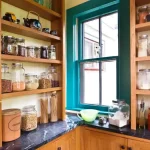When it comes to remodeling a kitchen, one of the first things most homeowners want to know is the cost. Cabinets are a significant part of that equation, often accounting for a big chunk of the budget. If you’re planning a kitchen remodel and wondering about the price tag for new cabinets, you’re in the right place.
The term “10×10 kitchen” might have caught your attention during your research, and there’s a good reason for that. It’s a standard layout used in the industry to estimate kitchen cabinet costs. But what does it really mean, and how does it help you budget for your project?
In this guide, we’ll break down everything you need to know about the cost of 10×10 kitchen cabinets. Whether you’re considering solid wood, plywood, or even custom designs, we’ll cover all the bases. By the end, you’ll have a clear understanding of what to expect and how to plan your kitchen remodel budget effectively.
Understanding the 10×10 Kitchen Layout
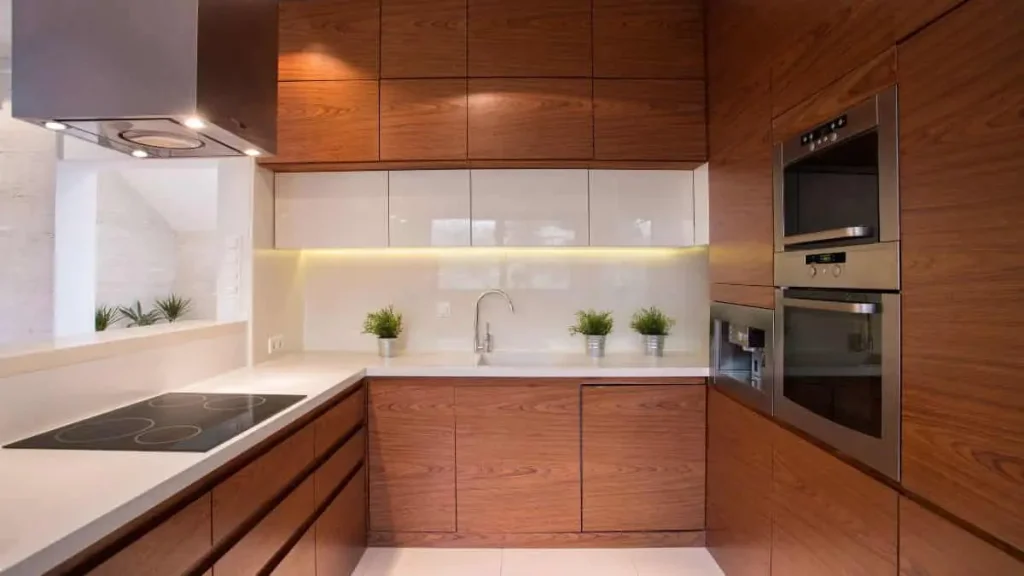
Before diving into the specifics of cabinet costs, it’s important to understand what a 10×10 kitchen layout actually is. Despite what it might sound like, a 10×10 kitchen doesn’t necessarily mean your kitchen measures exactly 10 feet by 10 feet. Instead, it’s a standard way of pricing kitchen cabinets in the industry.
What is a 10×10 Kitchen Layout?
A 10×10 kitchen layout is a sample layout that many cabinet manufacturers and retailers use to provide estimates. It typically includes a set number of cabinets placed in a space that’s 10 feet by 10 feet. This setup usually includes:
- Base Cabinets: Cabinets that sit on the floor and support the countertop.
- Wall Cabinets: Cabinets mounted on the wall above the countertop.
- Corner Cabinets: Special cabinets designed to maximize space in the corners.
This layout is purely for pricing purposes. It gives you a ballpark figure for what a standard set of cabinets might cost, allowing you to compare prices across different materials and suppliers.
Why is the 10×10 Layout Important for Estimating Costs?
The 10×10 layout is important because it simplifies the often overwhelming task of pricing out kitchen cabinets. Instead of getting lost in the details of your specific kitchen dimensions, you can start with this standard layout to get a sense of the cost range.
For example, when you see a price listed for a 10×10 kitchen in a showroom or online, you’ll know that’s the base cost for the cabinets. From there, you can adjust the estimate based on your kitchen’s actual size, your choice of materials, and any customizations you may want.
Understanding this layout is the first step toward creating a realistic budget for your kitchen remodel. As we move forward, we’ll explore the different materials, pricing ranges, and other factors that will affect the total cost of your 10×10 kitchen cabinets.
Types of Kitchen Cabinet Materials
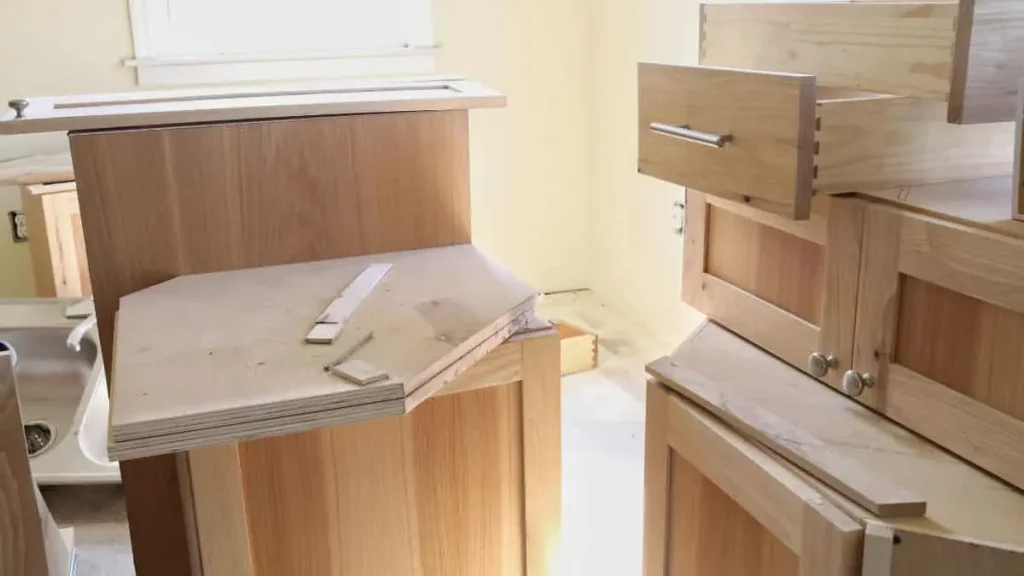
Choosing the right material for your kitchen cabinets is crucial, not just for aesthetics but also for durability and budget. Different materials come with their own set of pros, cons, and price points. Let’s dive into the most common types of kitchen cabinet materials you’ll encounter when planning your 10×10 kitchen remodel.
Solid Wood Cabinets
Solid wood cabinets are the gold standard in kitchen design. Known for their durability and timeless appeal, these cabinets are made from natural wood like oak, maple, or cherry. They can be stained, painted, or left in their natural state, offering versatility in design.
- Pros:
- Highly durable and long-lasting.
- Can be refinished or repainted over time.
- Adds significant value to your home.
- Cons:
- Prone to warping or cracking in extreme humidity.
- Typically more expensive than other materials.
- Cost Range: For a 10×10 kitchen, solid wood cabinets can range from $4,000 to $8,000, depending on the wood type and finish.
Plywood Cabinets
Plywood cabinets are a step down in cost from solid wood but still offer excellent strength and stability. Made from layers of wood veneers, plywood cabinets are less likely to warp and can support heavier countertops.
- Pros:
- Strong and stable, less prone to warping.
- More affordable than solid wood.
- Cons:
- Limited natural wood grain compared to solid wood.
- Edges may require additional finishing.
- Cost Range: Expect to pay between $3,000 and $6,000 for plywood cabinets in a 10×10 kitchen.
MDF (Medium-Density Fiberboard) Cabinets
MDF is a popular choice for those seeking a smooth, painted finish. This engineered wood product is made from wood fibers and resin, giving it a uniform surface that’s perfect for paint.
- Pros:
- Smooth surface ideal for painting.
- Resistant to cracking and warping.
- More affordable than plywood and solid wood.
- Cons:
- Less durable than solid wood and plywood.
- Susceptible to water damage if not properly sealed.
- Cost Range: MDF cabinets for a 10×10 kitchen typically range from $2,500 to $5,000.
Particleboard Cabinets
Particleboard is the most budget-friendly material on this list. Made from compressed wood chips and resin, it’s often used in low-end kitchen cabinets.
- Pros:
- Very affordable.
- Lightweight and easy to install.
- Cons:
- Least durable option; prone to damage and sagging.
- Highly susceptible to moisture damage.
- Cost Range: For a 10×10 kitchen, particleboard cabinets can cost between $1,500 and $3,000.
Metal and Glass Cabinets
If you’re aiming for a modern, industrial look, metal and glass cabinets might be right up your alley. These materials are typically used in high-end kitchens to create a sleek, contemporary aesthetic.
- Pros:
- Modern and stylish appearance.
- Durable and easy to clean.
- Resistant to moisture and pests.
- Cons:
- Can be expensive.
- May show fingerprints and smudges easily.
- Cost Range: Metal and glass cabinets in a 10×10 kitchen can range from $5,000 to $10,000, depending on the design and finish.
Pricing Ranges for 10×10 Kitchen Cabinets

Now that you know the different types of materials available, let’s break down the pricing ranges for a 10×10 kitchen. The cost can vary widely depending on the material, design, and any customizations you choose.
Low-End (Budget) Options
If you’re on a tight budget, you’ll likely gravitate towards particleboard or basic MDF cabinets. These materials are the most affordable but come with trade-offs in durability and longevity.
- Cost Range: $1,500 – $3,500
- Examples: Prefabricated particleboard cabinets from big-box retailers; basic MDF cabinets with laminate finishes.
Mid-Range Options
For those looking for a balance between quality and cost, mid-range options like plywood or higher-quality MDF are a good choice. These cabinets offer better durability and a wider range of design options.
- Cost Range: $3,500 – $7,000
- Examples: Semi-custom plywood cabinets; painted MDF cabinets with decorative finishes.
High-End (Luxury) Options
High-end cabinets are all about customization, premium materials, and luxury finishes. Solid wood, metal, and glass cabinets fall into this category, and they can significantly enhance the look and feel of your kitchen.
- Cost Range: $7,000 – $15,000+
- Examples: Custom solid wood cabinets with intricate details; sleek metal and glass cabinets for a modern kitchen.
Installation Costs
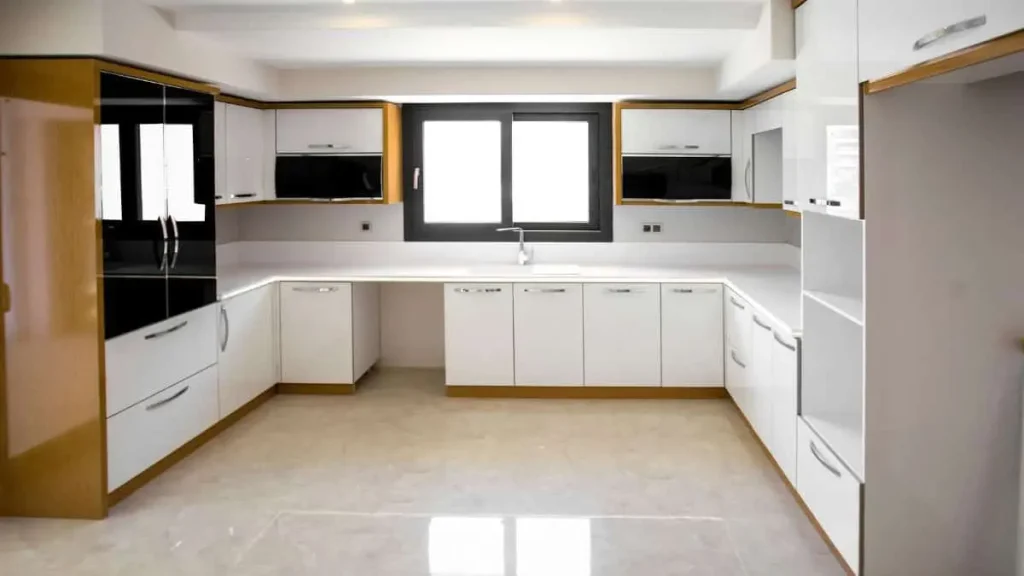
The cost of the cabinets themselves is just one part of the equation. Installation costs can also vary widely depending on whether you choose professional installation or go the DIY route.
Professional Installation
Hiring a professional to install your kitchen cabinets ensures the job is done right, but it does add to the overall cost. Installation typically involves not just hanging the cabinets but also aligning them properly, installing hardware, and ensuring everything is level.
- Average Cost: $3,000 – $5,000 for a 10×10 kitchen.
- Factors Affecting Cost:
- Location: Labor costs can vary based on your geographic location.
- Complexity: Custom cabinets or intricate layouts can increase labor time and costs.
- Additional Work: Any necessary prep work, like wall repairs or plumbing adjustments, will add to the cost.
DIY Installation
If you’re handy with tools and have some experience with home improvement projects, you might consider installing the cabinets yourself. This can save you a significant amount of money on labor costs.
- Cost Savings: You could potentially save $2,000 – $4,000 by doing the installation yourself.
- Considerations:
- Skill Level: Installing kitchen cabinets requires precision and skill. Mistakes can be costly to fix.
- Time Commitment: DIY installation can take much longer than professional installation, especially if it’s your first time.
Practical Tip: Consider combining professional and DIY efforts. For example, you might hire a pro for the trickier parts, like aligning and securing the base cabinets, while handling the easier tasks, like installing hardware, yourself.
Factors Affecting the Total Cost
While the material and installation choices are significant, other factors can also influence the overall cost of your 10×10 kitchen cabinets. Understanding these factors will help you better plan your budget and avoid unexpected expenses.
Cabinet Design and Style
The design and style of your cabinets play a crucial role in determining the cost. Simple, minimalist designs tend to be less expensive, while ornate, detailed designs can quickly increase the price.
- Custom Details: Features like intricate moldings, glass doors, and specialty hardware can add to the cost.
- Finish Options: High-gloss finishes, distressed looks, or hand-painted designs will also increase the price compared to basic paint or stain.
When planning a kitchen renovation, it’s crucial to consider both functionality and aesthetics. One of the most impactful upgrades you can make is refreshing your kitchen cabinets. While many homeowners opt to install new cabinets, others choose to revitalize their space with a fresh coat of paint. If you’re leaning towards the latter, learning how to paint kitchen cabinets like a pro can save you both time and money. But before you dive into the project, it’s important to consider the overall costs, especially if you’re dealing with specific layouts like a 10×10 kitchen.
Hardware and Accessories
The hardware you choose for your cabinets—such as knobs, handles, and hinges—can range from budget-friendly to high-end, luxury options.
- Basic Hardware: Standard hardware options are affordable and functional.
- Premium Hardware: Soft-close hinges, pull-out shelves, and custom organizers can significantly increase costs.
Cabinet Construction Quality
The quality of construction impacts both the price and durability of your cabinets.
- Box Construction: Cabinets with solid, well-built boxes will cost more than those with thinner, less sturdy construction.
- Joinery: Dovetail joints, dowels, and mortise-and-tenon construction methods are more durable but also more expensive than basic staples or nails.
Customization Options
Custom cabinets offer flexibility in design but come with a higher price tag.
- Custom Sizes: Non-standard cabinet sizes or shapes will increase costs.
- Special Features: Lazy Susans, pull-out pantries, and integrated lighting are great additions but will add to the budget.
Geographic Location
Where you live can impact the cost of your kitchen cabinets due to differences in labor rates, material availability, and shipping costs.
- Urban vs. Rural: Labor costs are generally higher in urban areas, while rural areas might have fewer options, potentially increasing costs due to limited availability.
- Shipping Costs: If your cabinets need to be shipped long distances, expect to pay more, especially for custom orders.
Tips for Budgeting Your 10×10 Kitchen Cabinets
Planning a kitchen remodel involves balancing your dreams with your budget. Here are some practical tips to help you stay within your budget without compromising on the quality or style of your cabinets.
Set a Realistic Budget
Before you start shopping for cabinets, determine how much you’re willing to spend. Remember to include costs for installation, hardware, and any additional features you want.
- Tip: Aim to allocate 40-50% of your kitchen remodel budget to cabinets, as they are a significant part of the overall cost.
Prioritize Your Must-Haves
Identify the features that are most important to you and allocate your budget accordingly. This might mean choosing a higher-end material for the cabinet fronts while opting for more affordable interiors.
- Tip: If you’re on a tight budget, consider splurging on the visible elements like doors and handles, while saving on less visible components like the cabinet boxes.
Explore Cost-Saving Alternatives
Look for ways to save money without sacrificing quality.
- Ready-to-Assemble (RTA) Cabinets: These can save you on both material and shipping costs since they’re shipped flat and require assembly.
- Mix and Match: Consider combining custom and prefabricated cabinets to get the look you want at a lower cost.
Plan for Unexpected Costs
No matter how well you plan, unexpected expenses can arise during a kitchen remodel. Set aside 10-20% of your budget as a contingency fund for any surprises.
- Tip: Be aware of potential hidden costs like the need to upgrade electrical wiring or plumbing to accommodate new cabinets.
Custom vs. Prefabricated Cabinets: Which Is Right for You?
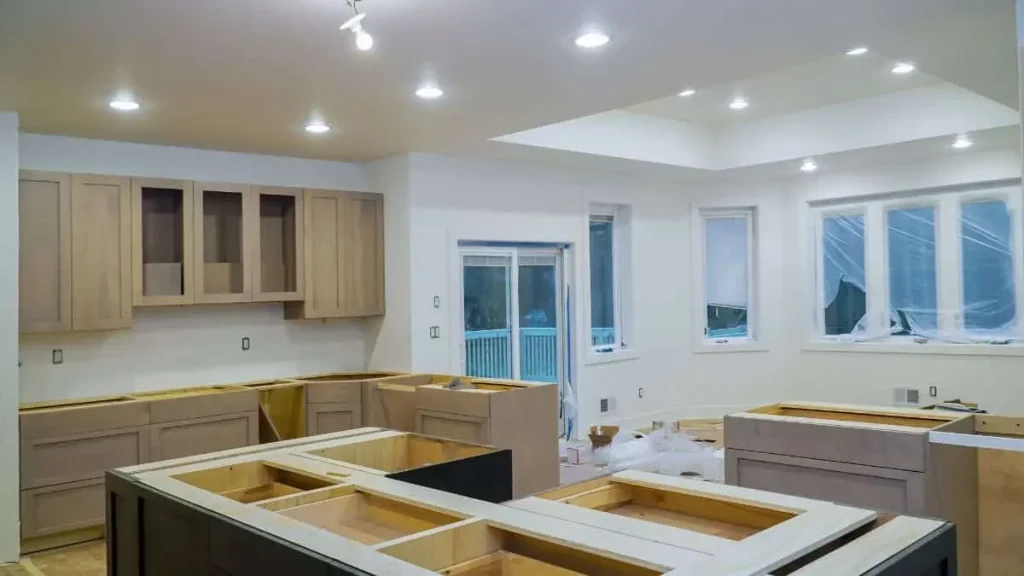
When deciding between custom and prefabricated cabinets for your 10×10 kitchen, it’s essential to weigh the pros and cons of each option. Your choice will depend on your budget, design preferences, and the level of customization you desire.
Custom Cabinets
Custom cabinets are built to your exact specifications, offering unlimited design possibilities. Whether you need specific dimensions, unique finishes, or specialized features, custom cabinets can be tailored to your vision.
- Pros:
- Perfect fit for your kitchen layout.
- High-quality materials and craftsmanship.
- Unlimited design and customization options.
- Cons:
- Significantly more expensive than prefabricated options.
- Longer lead times for production and installation.
- Ideal For: Homeowners with a larger budget who want a truly personalized kitchen that reflects their style and meets specific needs.
Prefabricated Cabinets
Prefabricated (or stock) cabinets are mass-produced and come in standard sizes and designs. These cabinets are typically available off-the-shelf or with shorter lead times than custom options.
- Pros:
- More affordable than custom cabinets.
- Quick and easy to install.
- Available in a wide range of styles and finishes.
- Cons:
- Limited customization options.
- May require fillers or spacers to fit your kitchen layout.
- Quality can vary depending on the manufacturer.
- Ideal For: Homeowners on a budget or those with a standard kitchen layout who want a quick and cost-effective solution.
Semi-Custom Cabinets: A Middle Ground
If you’re looking for something in between, semi-custom cabinets offer a balance of customization and affordability. These cabinets are pre-built but allow for some modifications, like resizing or choosing from a range of finishes.
- Pros:
- More customization options than prefabricated cabinets.
- More affordable than fully custom cabinets.
- Typically better quality than stock options.
- Cons:
- Still more expensive than prefabricated cabinets.
- Limited compared to fully custom designs.
- Ideal For: Homeowners who want a personalized touch without the high cost of custom cabinets.
Practical Tip: If you’re torn between custom and prefabricated options, consider a hybrid approach. Use custom cabinets for key areas like the island or a pantry, and opt for prefabricated cabinets for the rest of the kitchen.
Conclusion
Choosing the right kitchen cabinets is a significant decision that can impact both the aesthetics and functionality of your kitchen for years to come. When planning a 10×10 kitchen remodel, understanding the costs involved—from materials and installation to the various factors that can influence your budget—helps you make informed decisions.
Whether you opt for custom cabinets to achieve a one-of-a-kind look or choose prefabricated options for a more budget-friendly solution, the key is to find the balance that works best for you.
Remember, your kitchen is the heart of your home. Investing in quality cabinets not only enhances its beauty but also adds value to your home. With careful planning, smart budgeting, and a clear understanding of your options, you can create a kitchen that’s both stylish and functional—without breaking the bank.



